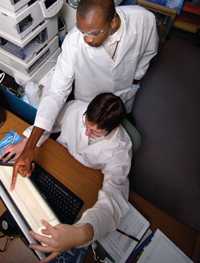Disease Surveillance and Monitoring
On This Page
Disease Surveillance and Monitoring [PDF – 317 KB]
CDC takes the health pulse of the American people
CDC tracks:
- Threats to health
- Leading causes of death
- How easy or hard it is to get health care in America
- Differences in health in various regions and among various groups of people CDC has several important data and tracking systems to accomplish this work.
CDC has several important data and tracking systems to accomplish this work.
Facts tell CDC the story

Information technology and world-class expertise allow CDC to track health trends and act to save lives and protect people.
With the right information, CDC and public health professionals can take effective and timely actions to save lives and keep Americans secure. CDC must have the newest technologies and methods available, such as advanced molecular detection, to keep America’s public health system on the forefront of keeping people safe.
Here’s a snapshot of 5 of our systems for tracking vital data:
- Through CDC’s National Vital Statistics System, states collect and disseminate statistics on births, deaths, marriages and fetal deaths.
- Through laboratory tracking throughout the country, we learn about tuberculosis (TB), HIV, influenza, and other illnesses; about hospital infections; and about sicknesses you can get from dirty or contaminated food and water.
- Through the Global Disease Detection program, we help countries monitor, detect, report and respond to health threats.
It took cooperation to get the world close to eradicating polio. It’s vital to have the Global Disease Detection program in place to handle new threats wherever and whenever they arise. With centers in 10 countries with limited resources, the Global Disease Detection program works with World Health Organization (WHO).
- Through the Behavioral Risk Factor Surveillance System (BRFSS), states can find data on personal health behaviors in their state.
Personal health behaviors such as seat belt use play a major role in preventable illnesses and early death.
States use BRFSS data to address urgent and emerging health issues. For example, during the 2004-2005 flu season, the BRFSS was used to monitor the influenza vaccine shortage.- The BRFSS is the largest telephone survey in the world. More than half a million interviews were conducted in 2014.
- BRFSS marked its 31st year in 2014 and remains the gold standard of behavioral surveillance.
- Currently data are collected monthly in all 50 states, the District of Columbia, American Samoa, Palau, Puerto Rico, the U.S. Virgin Islands, and Guam.
- Through CDC’s National Environmental Public Health Tracking Network we monitor:
- The state of our air, soil and water – to find out if anything in the environment poses a threat to human health.
- Trends in chronic and other health conditions – This information is crucial to identify health threats and to help Americans make choices that will give them longer, healthier lives.
Two success stories from the National Environmental Public Health Tracking Network

Information technology and world-class expertise allow CDC to track health trends and act to save lives and protect people.
Children and pregnant women were protected from the dangers of trichloroethylene (an industrial-use chemical). The chemical was found in indoor air at a daycare center, a batting cage complex, and many homes and businesses.
Nearly 26 million Americans have asthma. The Tracking Network has contributed to better management of asthma. The Tracking Network made possible a report on deaths in the U.S. due to asthma, challenges in treating this condition, and strategies to educate patients and others about asthma. Health departments and policy makers used the report to make recommendations about asthma management.
When a health threat appears, we may not know right away why or how many people are affected, but we have world-class expertise to find out what is making people sick or die and what to do about it.
- Page last reviewed: February 19, 2016
- Page last updated: February 19, 2016
- Content source:


 ShareCompartir
ShareCompartir